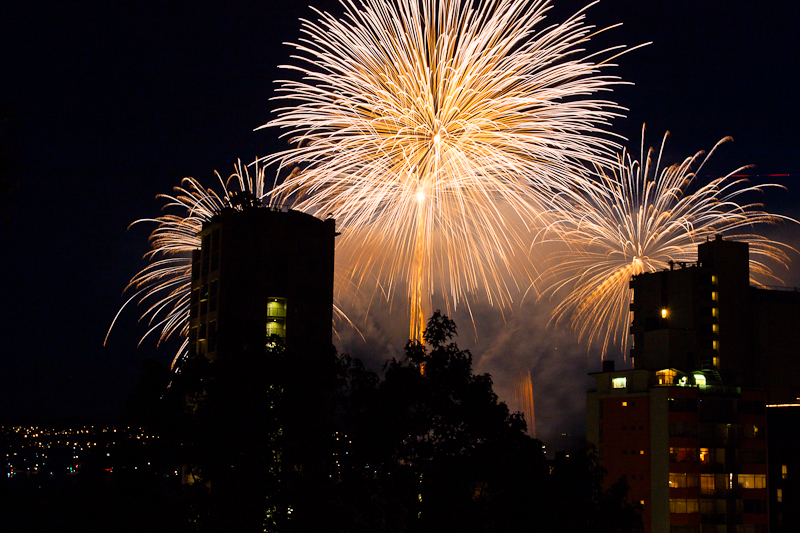In August 2020, my family and I moved into a century old farmhouse outside a small college town in Nebraska. Coming from the comparative megalopolis of St. Louis, we knew we would face adjustments, but we welcomed the chance to escape city life in the middle of pandemic conditions. We got excited about many of the changes even before arriving: the sheer space available in rural life, the surrounding farmland, the dual ponds in our backyard. But one major adjustment would take almost a year to register for us. Only in late June of 2021 did we come to appreciate how the frontier spirit of small town America manifests itself through the massive trade and deployment of backyard fireworks.
In the few weeks leading up to the fourth of July, tents begin to spring up in the Nebraska countryside, sprouting overnight like aggressive fungi. Our pyrotechnic shopping came predetermined for us, since our parish church had their own stand for the week before the holiday, but had we desired to price competitively, we could have done so at any number of stands in our small town, including one in the Dairy Queen parking lot. At any of them, we would have found a similar array: rows of plastic tables, arranged in a dangerously tight labyrinth, on which would be piled high stacks of cardboard containers bearing names like Donkey Balls, Tanxterminator, and Dragon Inferno. Need a firework shaped like a dog that emits fake turds when lit? They’ve got that. Sulfurous smoke bombs in all the colors of the rainbow? Check. The best part is the glittering illusion of plenty; while the bigger packs are a world to themselves, the smaller items tend to come wholesale, with “Buy 1, get 3 free” tags attached.
When we lived in St. Louis, we were subject to plentiful restrictions on shooting our own fireworks—anything much higher than sparkler-grade would have aroused the notice of the authorities. In return for this muted personal freedom, we yearly received a bountiful public display of grandeur, assuming we were willing to brave the crowds and stretch out on itchy grass for a few hours waiting for nature to put the lights down. Theoretically we could have attended a similar, though very scaled down, display in our small Nebraska town, but we never felt the need. For less than a hundred dollars, we could procure enough black powder to keep our kids thrilled for quite some time while limiting the amount of time and effort on our end.
The first year carried its share of mishaps. What to balance the numerous standing explosives on? Not grass, surely, and our gravel driveway had trees and powerlines dispersed at unfortunate intervals. We tried an old kid’s play table, hoping the plastic would prove durable enough for our purposes, but that quickly failed. Instead we settled on random pieces of plywood found in our landlord’s barn. Wife and kids well back, I would light the fuse and sprint back to safety like a decapitated rooster. More serious trouble arose at night’s end. Having exhausted our main supply of fireworks, we were left to discharge our final few Roman candles. Without a better option we stuck them in the ground near the back of where our living acreage ended and the farmland, rented separately by our landlord to a nearby farmer, began. I lit the first candle and ran, only to watch in dismay as the candle tilted in the soft ground and shot directly into a field of soybeans.
Though home-shot fireworks came with something of a learning curve for a confirmed city-slicker like myself, they proved to be more easily mastered than other aspects of country living while still providing me with some sense of accomplishment. By year two we had refined our technique enough to avoid anything resembling a mishap. My oldest son and I would alternate, lighting and running away while the others watched from a safe distance. The fireworks, perched on a sturdy board in the middle of the yard, would catch without too much trouble, showering the sky with fountains of fluorescent sparks, spinning and whirling, or else serenading us with popping cannonshot. Huddled together, my family and I would share in the small, modest joy of home.
I think that modesty, the embracing of limitations, brought me the most satisfaction. We could fire off enough whizbangs in an hour to satisfy my children for a whole year, without having to pack everyone up and endure the late-night fussing (or next morning hangover) of young children kept up past bedtime. For those sleep related reasons, we always fired well before the full encroachment of night, so we never achieved the full contrast of incandescence against a pitch-black background. Nor did we ever spend enough to acquire the truly grandiose pieces that would approximate, however poorly, a professional display. No heavenly aspirations for us; our reach, firmly within the limits of our grasp, remained where we could keep a close eye on it.
Not that such limitations extended everywhere. If there’s a dark side to the backyard fireworks trade, it sneaks in when people lose sight of what fireworks are finally for: the enrichment of a community. I knew someone who, every year, spent the two weeks leading up to the fourth of July sleeping at her family’s fireworks stand, constant vigilance activated in the quest for more sales. My wife heard stories of men who would set up secret bank accounts away from the prying eyes of their wives and slowly funnel money into them throughout the year, dropping upwards of $10,000 in a single fireworks purchase. When a spectacle such as a fireworks display becomes an end in itself, a way of demonstrating power or self-reliance or indifference to restraint, the wonder and delight quickly fizzle out, replaced by something grimmer.
Still, despite the minor risks to fingers and soul, I am thankful for my time as an amateur pyrotechnician. Having moved back to a city, my family and I often find ourselves yearning for the feeling of freedom we enjoyed for three years in the countryside. While backyard fireworks were, in the bigger picture, a small sliver of our life in Nebraska, they linger in my memory as a synecdochal representation of our time in the country. With a clear sky above us, no one restricting our movements, we learned—sometimes flailingly, like chickens with our heads cut off—how to marvel.
Image via Flickr












